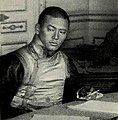Articles related to Mongolia include:
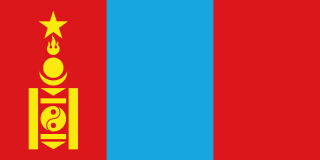
The Mongolian People's Republic was a socialist state that existed from 1924 to 1992, located in the historical region of Outer Mongolia in East Asia. Until 1990, it was a one-party state ruled by the Mongolian People's Revolutionary Party, and maintained close political and economic ties with the Soviet Union, as part of the Eastern Bloc.

Yumjaagiin Tsedenbal was a Mongolian politician who served as the leader of the Mongolian People's Republic from 1952 to 1984. He served as general secretary of the Mongolian People's Revolutionary Party from 1940 to 1954 and again from 1958 to 1984, chairman of the Council of Ministers from 1952 to 1974, and chairman of the Presidium of the People's Great Khural from 1974 to 1984.

The Mongolian People's Party (MPP) is a social democratic political party in Mongolia. It was founded as a communist party in 1920 by Mongolian revolutionaries and is the oldest political party in Mongolia. The party played an important role in the Mongolian Revolution of 1921, which was inspired by the Bolsheviks' October Revolution. Following independence, it governed Mongolia as a one-party socialist state. The party changed its name to the Mongolian People's Revolutionary Party (MPRP) and joined the Communist International in 1924 and served as a sole-ruling party of the Mongolian People's Republic.

Khorloogiin Choibalsan was a Mongolian politician who served as the leader of the Mongolian People's Republic as chairman of the Council of Ministers (premier) from 1939 until his death in 1952. He was also commander-in-chief of the Mongolian People's Army from 1937, and chairman of the Presidium of the State Little Khural from 1929 to 1930. A close ally of Joseph Stalin, Choibalsan led a dictatorship and organized Stalinist purges in Mongolia between 1937 and 1939 as head of the Ministry of Internal Affairs, executing tens of thousands of Mongolian citizens.

Damdin Sükhbaatar was a Mongolian communist revolutionary, founding member of the Mongolian People's Party, and leader of the Mongolian partisan army that took Khüree during the Outer Mongolian Revolution of 1921. For his part in the Outer Mongolian revolution of 1921, he was enshrined as the "Father of Mongolia's Revolution".

Jügderdemidiin Gürragchaa is a Mongolian cosmonaut and military leader. He was the first Mongolian and second Asian to go into space. He also was Mongolia's Defense Minister from 2000 to 2004.
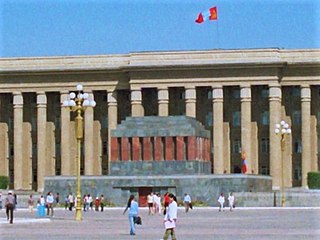
Sükhbaatar's Mausoleum was a mausoleum for Damdin Sükhbaatar, leader of the Mongolian Revolution of 1921, and Khorloogiin Choibalsan, leader of the Mongolian People's Republic from the late 1930s to his death in 1952, in Mongolia's capital Ulaanbaatar, on the northern side of Sükhbaatar Square in front of the Government Palace. The building was erected after Choibalsan's death during the socialist era, and removed in 2005 to make place for a structure dedicated to Genghis Khan. The mausoleum resembled the shape of Lenin's Mausoleum but differed in color. The mausoleum was never opened for public visits.

Anastasia Ivanovna Filatova was the Russian wife of the Mongolian leader Yumjaagiin Tsedenbal. She was often considered to be the de facto co-ruler of the Mongolian People's Republic.

Sükhbaatar Square is the central square of Mongolia's capital Ulaanbaatar. The square was named for Mongolian's revolutionary hero Damdin Sükhbaatar after his death in 1923. The square's name was changed to Chinggis Square in 2013 in honor of Genghis Khan, considered the founding father of Mongolia, but the original name was restored in 2016. The center of the plaza features an equestrian statue of Damdin Sükhbaatar, while a large colonnade monument dedicated to Genghis Khan, as well as to Ögedei Khan and Kublai Khan, dominates the square's north face directly in front of the Saaral Ordon.

Khatanbaatar Magsarjav was a Mongolian general and a leading figure in Mongolia's struggle for independence. His contingent of 800 elite Mongol soldiers fought White Russian and Chinese forces over 30 times between 1912 and 1921, without a single defeat. He served as acting prime minister from February 15, 1921 to March 13, 1921, under Roman Ungern von Sternberg's puppet regime and then later as minister of the army in the 1920s. He received the title Ardyn (Ардын) in 1924.

The Order of Sukhbaatar is a state decoration of Mongolia, originally instituted on 16 May 1941. It was awarded to Mongolians and foreigners "for special services to defenses, economic and cultural construction of the Mongolian People's Republic, and also for acts of heroism in the struggle against external and internal enemies". It was named after the Mongolian national hero, Damdin Sükhbaatar. It is still conferred today and has been the highest state order since 1992, awarded by the decree of the President of Mongolia.
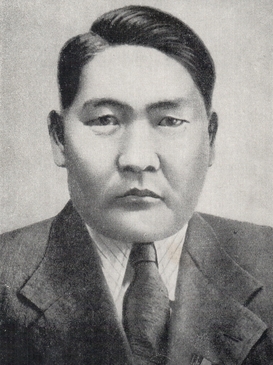
Dashiin Damba was a Mongolian politician who was the First Secretary of the ruling Mongolian People's Revolutionary Party from 1954 to 1958 during the brief period of collective leadership in the country after the death of Khorloogiin Choibalsan. Damba was ousted and sent into internal exile by leader Yumjaagiin Tsedenbal due to his support for de-Stalinization policies.
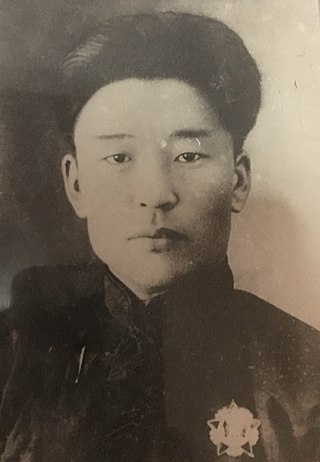
Banzarjavyn Baasanjav was leader of the Mongolian People's Revolutionary Party from 1936 to 1940. Prime Minister Khorloogiin Choibalsan arranged for his arrest and subsequent execution on charges of counterrevolution in 1940 to free up the party leadership role for Yumjaagiin Tsedenbal.
Sonomyn Luvsan was a prominent Mongolian politician and diplomat who was acting Chairman of the Presidium of the People's Great Khural of the Mongolian People's Republic or MPR from June 29, 1972 to June 11, 1974.

Sambadondogiin Tserendorj was recognized as the 6th reincarnate of the Donkor-Manjushri Gegen. He served as chief abbot of the Manjusri Monastery and later was the last acting prime minister of Outer Mongolia during Baron Ungern von Sternberg's occupation of Ikh Khŭree from May to July 1921. Later accused of counterrevolution, he was executed in 1937 at the start of the Stalinist purges in Mongolia (1937–1939).
The Altan-Ölgii National Cemetery is a cemetery located in Ulaanbaatar, Mongolia.

The Order of the Red Banner is a military decoration of Mongolia, originally established as the "Order for Military Merit" of the People's Republic of Mongolia. The medal has been awarded to citizens as well as foreigners and institutions for services to the state. Renamed in 1945 as simply the "Order of the Red Banner", the design of the medallion has been changed several times, and in 1961 the ribbon bar of was changed before it was renamed to the "Order of the Red Banner for Military Valor" in 1993.
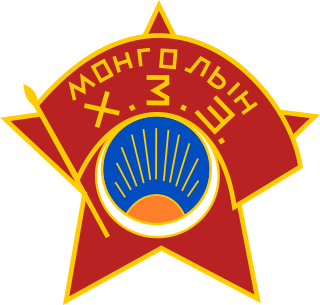
The Mongolian Revolutionary Youth League was a youth movement in the Mongolian People's Republic under the Mongolian People's Revolutionary Party.

The Medal "For the Victory over Japan" was a medal of the Mongolian People's Republic was established by the decree of the Presidium of the Little Khural on November 20, 1945 to commemorate the victory in the Soviet–Japanese Conflict of the Second World War.


